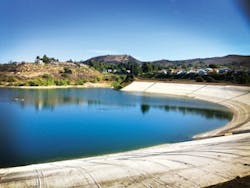About the author: Amy McIntosh is associate editor for W&WD. McIntosh can be reached at [email protected] or 847.954.7966.
In the middle of Anaheim, Calif.’s scenic Anaheim Hills neighborhood is the August T. Lenain Water Treatment Plant (WTP). With its stucco walls, tile roofs and native landscaping, the plant blends into the neighboring community as it treats 15 million gal per day of water.
During this year’s American Water Works Assn. Annual Conference and Exposition, visitors will be able to tour the WTP, which is situated on a 1.5-acre site on an earthen bench constructed in a sloping canyon, adjacent to the 920-million-gal Walnut Canyon Reservoir (WCR). The plant is the only city-owned WTP in Orange County.
Maximizing the Footprint
The Lenain WTP was built in 1969 and underwent a major upgrade in 1995 to modernize the treatment process. Because the city was unable to expand past the 1.5-acre pad on which the original plant was built, steps were taken to maximize the available space. Chemical systems were moved to the basement of the operations building, facilities were built as close as 4 in. apart and inclined plate settlers were installed to minimize the footprint of the sedimentation basins.
The plant employs a conventional treatment process with ozone disinfection. A water system control center, also installed during the 1995 upgrade, houses the plant’s control system. The WTP also has an onsite state-certified water quality laboratory.
The Metropolitan Water District of Southern California operates the Colorado River Aqueduct, which supplies water to the WCR from Lake Mathews, located in Riverside County. The Lenain WTP draws its water from the WCR, which covers almost 50 acres and measures 100 ft deep at its deepest point. When the reservoir needs to be offline, the plant can bypass the WCR, instead drawing directly from the lake.
Reservoir Remedies
This bypass was employed twice in 2010 when water quality issues in the WCR required the reservoir to go offline so taste and odor compounds—namely geosmin and 2-methylisoborneol (2-MIB)produced by cyanobacteria—could be addressed. Copper sulfate was added to kill the cyanobacteria, and when the geosmin concentration declined, operators increased the ozone dosage and blended WCR water with the bypassed water from Lake Mathews.
In the summer, anoxia formation poses a treatment challenge for the WTP, as the reservoir is thermally stratified from March to October. The plant historically drew its water from the epiliminion, or the topmost layer, as the quality was better there than in the deeper layer—the hypolimnion—below the thermocline. By June, dissolved oxygen (DO) levels in the hypolimnion typically dropped to zero, resulting in the presence of hydrogen sulfide, iron, manganese, ammonia and phosphate due to anaerobic respiration. These compounds created a number of water quality concerns, including unpleasant odors, stains and algal growth.
“These compounds accumulated over the course of summer, and when the fall and winter came, the entire water column mixed (called lake turnover), redistributed the compounds and possibly triggered multiple water quality issues in the following years,” said Keisuke Ikehata, Ph.D., P.E., advanced water research and development manager for PACE, the engineering firm hired by the city of Anaheim to address the water quality issues in the WCR.
The city and PACE created a bottom water withdrawal and fill-draw schedule to help alleviate the problem without adding chemicals or new equipment. By withdrawing the source water from the bottom layer instead of the top, and also mixing in water from Lake Mathews, the water quality improved. PACE also recommended lowering the reservoir water level during spring and summer to reduce the thickness of the hypolimnion, and filling it up when the reservoir turned over in the fall.
“Our water quality monitoring data suggest that the bottom water withdrawal maintained weak stratification during summer and introduced significant DO (greater than 5 mg/L) to the hypolimnion of the WCR,” Ikehata said. “The downward motion of water probably discouraged algal blooms, while bottom sediments never became anoxic (septic) again, but always fully oxidized and cleaned.”
The plant has not experienced a taste and odor problem in three years, but if one should occur, it is prepared.
“PACE has recommended the city utilize the hydrogen peroxide injection facilities for advanced oxidation process and ozone residual quenching to enhance the geosmin/2-MIB degradation when another taste and odor event occurs,” Ikehata said. “However, no taste and odor event has occurred since 2012 and we’ve never had a chance to test this strategy, fortunately.”
Download: Here
